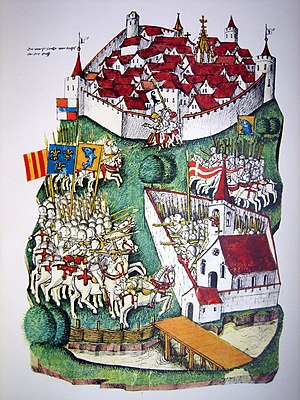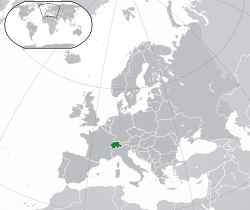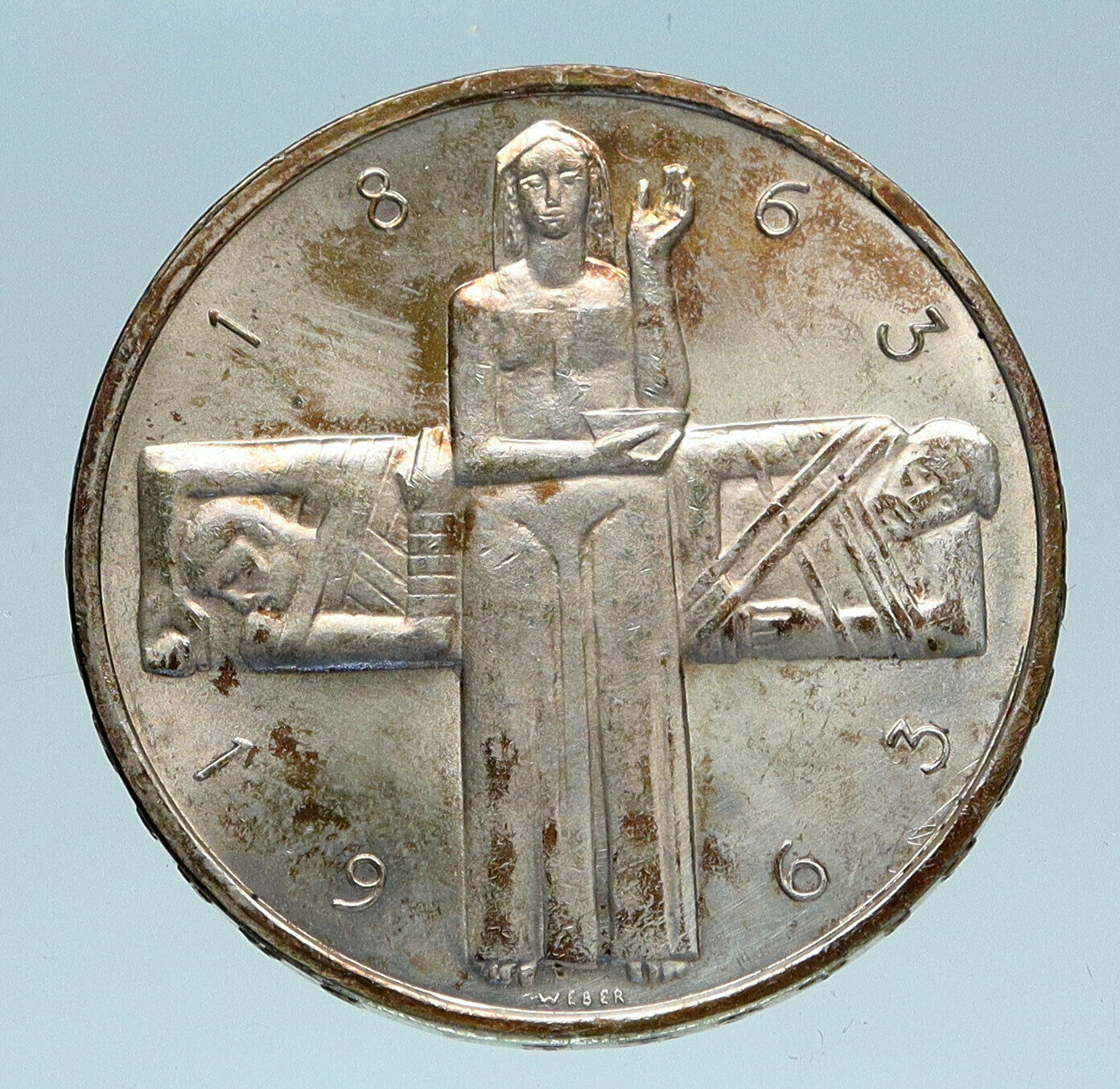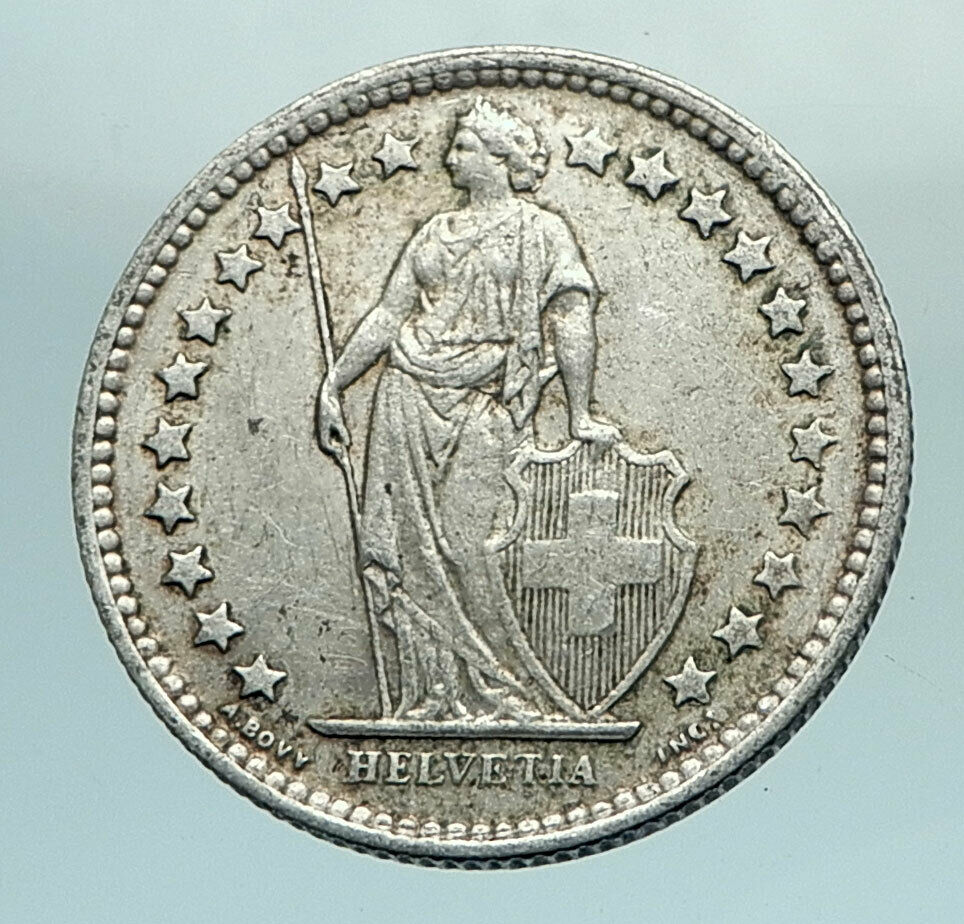|
Switzerland – 500th Anniversary of the Battle of St. Jakob an der Birs Commemorative
1944 Silver 5 Francs 31mm (15.00 grams) 0.835 Silver (0.4027 oz. ASW)
Reference: KM# 45 | Certification: NGC MS 64 3489005-044
HELVETIA, Kneeling figure looking right; engraver’s name, E.WEIDERKEHR in right field.
5 FR MORI MALUNT QUAM SUPERARI ST. JAKOB AN DER BIRS MCDXLIV B 1944, Cross of Switzerland.
You are bidding on the exact item pictured, provided with a Certificate of Authenticity and Lifetime Guarantee of Authenticity.
 The Battle of St. Jakob an der Birs was fought between the Old Swiss Confederacy and French (mostly Armagnac) mercenaries, on the banks of the river Birs. The battle took place on 26 August 1444 and was part of the Old Zürich War. The site of the battle was near Münchenstein, Switzerland, just above 1 km outside the city walls of Basel, today within Basel’s St-Alban district. The Battle of St. Jakob an der Birs was fought between the Old Swiss Confederacy and French (mostly Armagnac) mercenaries, on the banks of the river Birs. The battle took place on 26 August 1444 and was part of the Old Zürich War. The site of the battle was near Münchenstein, Switzerland, just above 1 km outside the city walls of Basel, today within Basel’s St-Alban district.
Background
In 1443, the seven cantons of the Old Swiss Confederacy invaded the canton of Zürich and besieged the city. Zürich had made an alliance with Frederick III, Holy Roman Emperor, who now appealed to Charles VII of France to send an army to relieve the siege.
Charles, seeking to send away the “écorcheurs”, troublesome troops made idle by the truce with Henry VI of England in the Hundred Years’ War, sent his son the Dauphin (later Louis XI of France) with an army of about 30,000 of these écorcheurs into Switzerland, most of them Armagnacs, to relieve Zürich.[1] As the French forces entered Swiss territory at Basel, the Swiss commanders stationed at Farnsburg decided to send an advance troop of 1,300, mostly young pikemen. These moved to Liestal on the night of 25 August, where they were joined by a local force of 200.
The battle
In the early morning, they managed to surprise and rout French vanguard troops at Pratteln and Muttenz. Enthused by this success, and in spite of strict orders to the contrary, the Swiss troops crossed the Birs to meet the bulk of the French army of some 30,000 men, which was ready for battle.
Immediately the Swiss forces formed three pike squares of five hundred men each, and they fought well when Armagnac cavalry charged again and again and were repulsed.
Aeneas Silvius Piccolomini (1405-1464, later Pope Pius II, until 1439 participant in the Council of Florence), described the battle in vivid detail, telling how the Swiss ripped bloody crossbow bolts from their bodies, and charged the enemy even after they had been pierced by spears or had lost their hands, charging the Armagnacs to avenge their [own] deaths.
The fighting lasted for several hours and was of an intensity evoking awed commentary from witnesses. Eventually, the Swiss pike squares weakened, so the commander ordered his men to retreat into a small hospital of St. Jakob. A reinforcement force from Basel was repulsed, and the Armagnac troops set their own artillery to bombarding the hospital. The Swiss pikemen suffered heavy casualties. The Swiss, as the offensive party, categorically refused to surrender and as the Armagnacs moved into the hospital, the remaining Swiss were pressed into the hospital’s garden and killed to the last man within half an hour.
Aftermath
Even though the battle itself was a devastating defeat for the Swiss, and a major blow to Bern, the canton which contributed the force, it was nevertheless a Swiss success in strategic terms. In view of the heavy casualties on the French side, the original plan of moving towards Zürich, where a Swiss force of 30,000 was ready, was now judged unfavourably by the Dauphin and the French troops turned back, contributing to the eventual Swiss victory in the Old Zürich War. The actions of the Swiss was praised as heroic by contemporary observers and reports of the event quickly spread throughout Europe.
The Dauphin formally made peace with the Swiss Confederacy and with Basel in a treaty signed at Ensisheim on 28 October, and withdrew his troops from the Alsace in the spring of 1445. The intervention of the Church Council being held in the city of Basel at that time was crucial in instigating this peace: the Swiss Confederates were allies of the city of Basel, and so the Dauphin’s war could also be construed as an aggressive act against the Council housed within its walls. Charles VII of France had implemented the reformist decrees of the Council of Basel in 1438, so it was important for the Dauphin not to appear to be threatening its members.
In terms of military tactics, the battle exposed the weakness of pike formations against artillery, marking the beginning of the era of gunpowder warfare.
Legacy in Swiss historiography and patriotism
While the sheer bravery or foolhardiness on the Swiss side was recognized by contemporaries, it was only in the 19th century, after the collapse of the Napoleonic Helvetic Republic, that the battle came to be stylized as a kind of Swiss Thermopylae, a heroic and selfless rescue of the fatherland from a French invasion.[5]
The battle became a symbol of Swiss military bravery in the face of overwhelming odds and was celebrated in 19th century Swiss patriotism, finding explicit mention in Rufst du, mein Vaterland, the Swiss national anthem from the 1850s to 1961. A first monument at the site of the battle was erected in 1824, the current monument by Ferdinand Schlöth dates to 1872. Memorial ceremonies at the site were held from 1824, from 1860 to 1894 on a yearly basis, and afterwards every five years (discontinued after 1994).
The death of knight Burkhard VII. Münch, according to the chroniclers at the hands of a dying Swiss fighter, became symbolic of the outcome of the battle and the strategy of deterring powers of superior military strength from invading Switzerland by the threat of inflicting disproportionate casualties even in defeat, pursued by Swiss high command during the World Wars.
.svg/85px-Coat_of_Arms_of_Switzerland_(Pantone).svg.png)  Switzerland, officially the Swiss Confederation (Latin: Confoederatio Helvetica, hence its abbreviation CH), is a federal parliamentary republic consisting of 26 cantons, with Bern as the seat of the federal authorities, the so-called Bundesstadt (“federal city”). The country is situated in Western and Central Europe, where it is bordered by Italy to the south, France to the west, Germany to the north, and Austria and Liechtenstein to the east. Switzerland is a landlocked country geographically divided between the Alps, the Swiss Plateau and the Jura, spanning an area of 41,285 km2 (15,940 sq mi). While the Alps occupy the greater part of the territory, the Swiss population of approximately 8 million people is concentrated mostly on the Plateau, where the largest cities are to be found. Among them are the two global cities and economic centres of Zürich and Geneva. Switzerland, officially the Swiss Confederation (Latin: Confoederatio Helvetica, hence its abbreviation CH), is a federal parliamentary republic consisting of 26 cantons, with Bern as the seat of the federal authorities, the so-called Bundesstadt (“federal city”). The country is situated in Western and Central Europe, where it is bordered by Italy to the south, France to the west, Germany to the north, and Austria and Liechtenstein to the east. Switzerland is a landlocked country geographically divided between the Alps, the Swiss Plateau and the Jura, spanning an area of 41,285 km2 (15,940 sq mi). While the Alps occupy the greater part of the territory, the Swiss population of approximately 8 million people is concentrated mostly on the Plateau, where the largest cities are to be found. Among them are the two global cities and economic centres of Zürich and Geneva.
The establishment of the Swiss Confederation is traditionally dated to 1 August 1291, which is celebrated annually as Swiss National Day. It has a long history of armed neutrality-it has not been in a state of war internationally since 1815-and did not join the United Nations until 2002. It pursues, however, an active foreign policy and is frequently involved in peace-building processes around the world. Switzerland is also the birthplace of the Red Cross and home to numerous international organizations, including the second largest UN office. On the European level, it is a founding member of the European Free Trade Association and is part of the Schengen Area – although it is notably not a member of the European Union, nor the European Economic Area. Switzerland comprises four main linguistic and cultural regions: German, French, Italian and the Romansh-speaking valleys. Therefore, the Swiss, although predominantly German-speaking, do not form a nation in the sense of a common ethnic or linguistic identity; rather, the strong sense of identity and community is founded on a common historical background, shared values such as federalism and direct democracy, and Alpine symbolism.
Switzerland has the highest nominal wealth per adult (financial and non-financial assets) in the world according to Credit Suisse and eighth-highest per capita gross domestic product on the IMF list. However, Switzerland is also the most expensive country in the world to live in, as measured by the price level index.
Swiss citizens have the second-highest life expectancy in the world on the UN DESA list. Switzerland is tied with the Netherlands for the top rank on the Bribe Payers Index indicating very low levels of business corruption. Moreover, for the last five years the country has been ranked first in economic and tourist competitiveness according to the Global Competitiveness Report and the Travel and Tourism Competitiveness Report respectively, both developed by the World Economic Forum. Zürich and Geneva have each been ranked among the top cities with the highest quality of life in the world, with the former coming second globally according to Mercer. However, Mercer also rates those two cities as the fifth- and sixth- most expensive cities in the world to live in.
|









 The Battle of St. Jakob an der Birs was fought between the Old Swiss Confederacy and French (mostly Armagnac) mercenaries, on the banks of the river Birs. The battle took place on 26 August 1444 and was part of the Old Zürich War. The site of the battle was near Münchenstein, Switzerland, just above 1 km outside the city walls of Basel, today within Basel’s St-Alban district.
The Battle of St. Jakob an der Birs was fought between the Old Swiss Confederacy and French (mostly Armagnac) mercenaries, on the banks of the river Birs. The battle took place on 26 August 1444 and was part of the Old Zürich War. The site of the battle was near Münchenstein, Switzerland, just above 1 km outside the city walls of Basel, today within Basel’s St-Alban district. .svg/85px-Coat_of_Arms_of_Switzerland_(Pantone).svg.png)
 Switzerland, officially the Swiss Confederation (Latin: Confoederatio Helvetica, hence its abbreviation CH), is a federal parliamentary republic consisting of 26 cantons, with Bern as the seat of the federal authorities, the so-called Bundesstadt (“federal city”). The country is situated in Western and Central Europe, where it is bordered by Italy to the south, France to the west, Germany to the north, and Austria and Liechtenstein to the east. Switzerland is a landlocked country geographically divided between the Alps, the Swiss Plateau and the Jura, spanning an area of 41,285 km2 (15,940 sq mi). While the Alps occupy the greater part of the territory, the Swiss population of approximately 8 million people is concentrated mostly on the Plateau, where the largest cities are to be found. Among them are the two global cities and economic centres of Zürich and Geneva.
Switzerland, officially the Swiss Confederation (Latin: Confoederatio Helvetica, hence its abbreviation CH), is a federal parliamentary republic consisting of 26 cantons, with Bern as the seat of the federal authorities, the so-called Bundesstadt (“federal city”). The country is situated in Western and Central Europe, where it is bordered by Italy to the south, France to the west, Germany to the north, and Austria and Liechtenstein to the east. Switzerland is a landlocked country geographically divided between the Alps, the Swiss Plateau and the Jura, spanning an area of 41,285 km2 (15,940 sq mi). While the Alps occupy the greater part of the territory, the Swiss population of approximately 8 million people is concentrated mostly on the Plateau, where the largest cities are to be found. Among them are the two global cities and economic centres of Zürich and Geneva.




